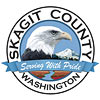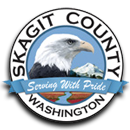Welcome to Skagit County

Dozens gather at local drill built around hypothetical crude oil car derailment
SKAGIT COUNTY - It was a scene reminiscent of a childhood adventure with
a model train - but this was a tabletop event with potential life and death
ramifications.
Several dozen local emergency responders gathered Wednesday, April 9 for a
tabletop exercise built around the hypothetical derailment of a train transporting
Bakken crude oil. The event was hosted and facilitated by the Skagit County
Department of Emergency Management in cooperation with the City of Mount Vernon.
Organizers suggested the overwhelmingly positive attendance at the drill was
a reflection of the commitment of local agencies, businesses and elected officials
to the kind of mutual response effort required in the wake of disasters such
as bridge collapses, mudslides and train derailments.
Those in attendance ranged from local emergency response officials to Mount
Vernon Mayor Jill Boudreau and staffers from the offices of U.S. Sen. Patty
Murray and U.S. Rep. Rick Larsen. Given the fact that the scenario involved
the derailment of cars from a crude oil train, key players in the drill were
representatives from the federal government, BNSF Railway, Tesoro and Shell
refineries.
Before the morning session had ended, the drill engaged participants including
fire responders, police departments, emergency dispatchers, Washington State
Patrol, Skagit Valley College, American Red Cross, and local, state and federal
agencies.
Because the hypothetical train derailment took place as a consequence of a
collision between a semi-truck and BNSF "unit train" at the College
Way intersection, first responder in the drill was Mount Vernon Fire Battalion
Chief Bryan Harris.
Capt. Andy Smith of the U.S. Environmental Protection Agency (EPA) was also
in attendance, noting that his possible role as federal on-scene coordinator
would depend on the magnitude of the disaster.
As details of the drill scenario were revealed, potential responders in the
audience were invited to weigh in regarding the personnel, equipment and services
they might provide. Also discussed were likely challenges ranging from medical
injuries and interagency/public communications to traffic issues and incident
command organization.
EPA representative Smith suggested, "All incidents are local." He
said it would be vital to quickly define any threat to the public and identify
each response organization's objectives going into establishment of an incident
command system to address both short- and long-term challenges.
BNSF officials reinforced their commitment to the safe movement of crude oil,
and to being prepared to respond immediately in the case of an incident. The
railroad's response plan includes having specialized equipment and hazardous
materials responders staged across its network, which includes several locations
in Washington such as Everett, Seattle, Longview, Wishram, Pasco and Spokane.
BNSF Regional Director of Public Affairs Courtney Wallace said, "Participating
in these types of exercises is very important as they give us an opportunity
to collaborate with our partners in the communities where we operate. We are
able to learn from each other and further our mutual goal of safety and security."
Tesoro and Shell representatives referenced their trained responders and equipment
including large quantities of foam. Each expressed willingness to act in a
mutual response capacity, with magnitude of that response dependent on incident
details.
Mount Vernon Fire Chief Roy Hari said of the drill: "I was impressed
with all the various agencies represented today. It not only demonstrates
the keen interest and concern we all share around these products, but the
commitment of each agency as to how we will handle things should we have an
accident. It is through these drills that we are better prepared to handle
emergencies of this nature if and when they occur."
Emergency Management Director Mark Watkinson said: "I am very happy with
the number of people who participated. The information that was shared today
will be of benefit to emergency response agencies throughout Skagit County."
Additional training provided by BNSF is planned in the fall, with commitment
by various participants to prepare more detailed response plans by that time.
(Note: High resolution images available on request. Contact Steve Berentson,
stephenb@co.skagit.wa.us) OR
360-293-4852



















